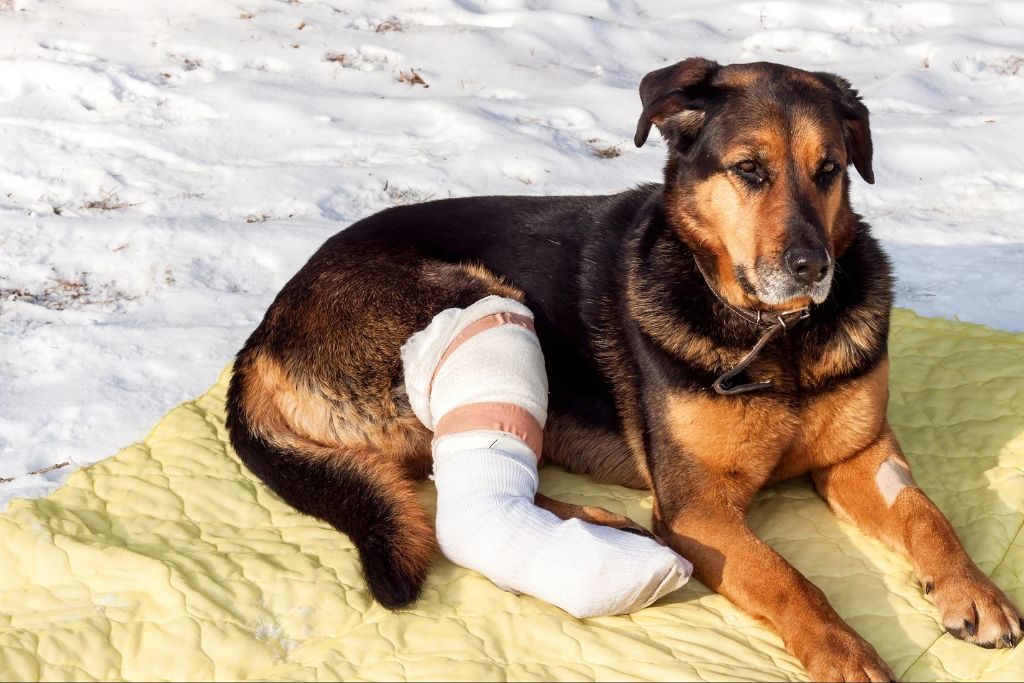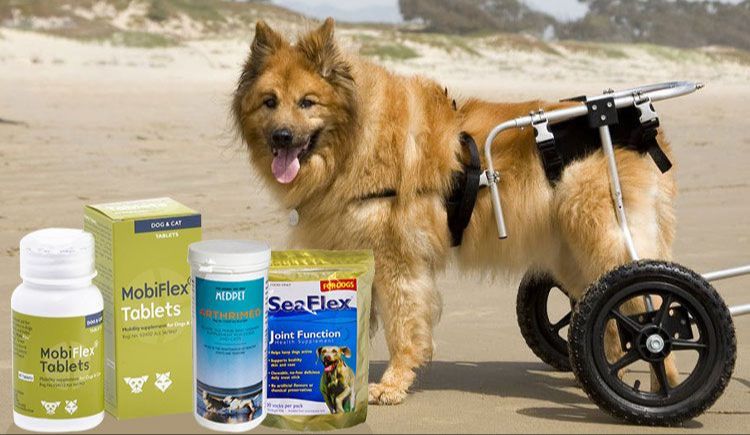Introduction
Many dog owners watch helplessly as their once energetic and playful pets slow down and show signs of pain and stiffness. The culprit? Often, it’s arthritis. According to statistics, approximately 20% of dogs will be diagnosed with arthritis, and the condition becomes more common as dogs age.
Seeing a beloved dog struggle with arthritis can be heartbreaking. But what many owners may not realize is that like humans, dogs have their good days and bad days when dealing with this progressive condition. On the bad days, symptoms like limping or reluctance to go on walks may be more pronounced. On the good days, arthritis may cause less pain and stiffness. Understanding this fluctuation in symptoms can help owners better care for an arthritic dog.
This article explores the question: Do dogs have good days and bad days with arthritis? We’ll look at the causes of arthritis, typical symptoms, treatment options, and how to help dogs on their more difficult days. By learning what to expect with the ups and downs of canine arthritis, owners can provide the best possible care and quality of life.
What Causes Arthritis in Dogs
There are two main types of arthritis that affect dogs: osteoarthritis and inflammatory arthritis. Osteoarthritis (OA), also known as degenerative joint disease, is the most common type of arthritis in dogs and is caused by wear and tear on the joints over time. Factors that contribute to osteoarthritis include obesity, joint injuries, aging, and genetic factors. Inflammatory arthritis involves the immune system attacking the joints and can be caused by infections or autoimmune disorders.
Joint injuries, such as ligament tears or fractures, are a major cause of osteoarthritis in dogs. Damage to the cartilage, ligaments, or bones within a joint from an injury can lead to instability, abnormal wear, and inflammation. Over time, these changes cause osteoarthritis. According to the AKC Canine Health Foundation, injury is one of the most common causes of osteoarthritis in dogs (AKCCHF).

Obesity is another significant risk factor for osteoarthritis in dogs. The extra weight puts increased pressure on the joints and accelerates cartilage breakdown. Even an overweight dog is at greater risk for developing osteoarthritis. According to the VCA Hospitals, obesity can contribute to and worsen arthritis (VCA).
Genetics can also play a role in osteoarthritis. Some dog breeds are prone to developing joint problems and arthritis due to conformational characteristics. For example, hip and elbow dysplasia are common in larger breeds and can lead to osteoarthritis. Certain breeds like Labrador Retrievers and German Shepherds are at increased genetic risk for osteoarthritis (AKCCHF).
Signs of Arthritis in Dogs
Some of the most common signs of arthritis in dogs include limping and stiffness. According to the VCA Hospitals (https://vcahospitals.com/know-your-pet/arthritis-in-dogs), dogs with arthritis often walk stiffly, show lameness in one or more legs, and have difficulty getting up and down. The stiffness and lameness is often worse after exercise and when first waking up. In more severe cases, dogs may stop putting weight on a painful limb altogether.
In addition to limping and stiffness, dogs with arthritis tend to become less active as the condition progresses. They may have decreased stamina for walks or playtime. Some dogs even become reluctant to climb stairs or jump on furniture if it is too painful. Along with decreased activity comes muscle atrophy and loss of muscle mass, especially in the affected limbs.
Personality changes can also indicate arthritic pain in dogs. According to Blue Cross (https://www.bluecross.org.uk/advice/dog/health-and-injuries/arthritis-in-dogs), dogs with arthritis may show signs of irritability, aggression, depression, or other behavioral changes. This is due to the chronic discomfort and pain caused by the arthritis. Dogs that previously enjoyed being petted or touched may begin to snap or bite when in pain. Providing pain management and treatment is important to stop negative behavior changes.
Variability of Symptoms

Like humans with arthritis, dogs can have good days and bad days when it comes to their arthritis symptoms. As mentioned in this article, dogs with arthritis may experience flare-ups where their symptoms worsen for a period of time before improving again. The severity of their symptoms can vary quite a bit from day to day.
There are many factors that can influence the variability of arthritis symptoms in dogs. Changes in the weather, increased activity, overexertion, and even the timing of medications can all affect how pronounced their symptoms are on any given day. Arthritis pain may be worse in cold, damp weather or when a dog has been more active than usual. Just like humans, these flare-ups are often unpredictable.
While it can be frustrating to see your dog struggling with increased pain and stiffness on bad days, the good news is that these flares are usually temporary. With rest, medication adjustments, and TLC from their owner, dogs can bounce back to improved comfort and mobility on their good days. Being aware of the variable nature of arthritis helps owners be patient on their pet’s bad days and cherish the good ones.
Diagnosing Arthritis
To diagnose arthritis in dogs, the veterinarian will start with a thorough physical examination. They will check all the joints for swelling, pain, and limited range of motion. According to VCA Animal Hospitals, palpation, or feeling the joints and muscles, allows the vet to localize areas of pain and determine its severity.
Additional diagnostic tests like x-rays and blood tests may be recommended. X-rays allow the veterinarian to see signs of arthritis not visible externally, like bone spurs and narrowed joint spaces. Blood tests help rule out other potential causes of the symptoms.
Veterinarians may also prescribe a trial course of pain medication. If the dog’s symptoms improve, it helps confirm the arthritis diagnosis. According to the AKC Canine Health Foundation, responding positively to treatment is an important part of diagnosing canine arthritis.
Sources:
https://vcahospitals.com/know-your-pet/arthritis-in-dogs
https://www.akcchf.org/canine-health/your-dogs-health/caring-for-your-dog/managing-canine-arthritis.html
Treatment Options
There are several treatment options available to help manage arthritis pain and improve quality of life for dogs. Some of the main treatment approaches include:

Weight Management
Keeping your dog at a healthy weight is crucial, as extra pounds put more strain on already painful joints. Work with your vet to determine your dog’s ideal weight range and adjust their diet and exercise accordingly. For overweight dogs, a weight loss program can make a big difference in arthritis symptoms.
Exercise
While it may seem counterintuitive, appropriate exercise can help strengthen muscles, improve joint flexibility, and reduce pain. Low-impact activities like short walks, swimming, or gentle stretches are usually well-tolerated. Always start slowly and stop if you notice signs of overexertion. Your vet can suggest an exercise plan tailored to your dog’s needs.
Physical Therapy
Physical therapy techniques like therapeutic laser, massage, and passive range of motion exercises can provide pain relief and improve joint mobility. Many vets now offer rehabilitation services or can refer you to a canine physical therapist. Additional options like acupuncture or hydrotherapy may also help.
Medications
Several types of medications can minimize arthritis discomfort and slow disease progression. Common options include nonsteroidal anti-inflammatory drugs (NSAIDs), joint supplements, and steroids or opioids for severe pain. Your vet will prescribe the safest, most effective medication regimen for your dog.
Living with an Arthritic Dog
Living with an arthritic dog requires making some adjustments to accommodate their changing needs. Some tips for managing life with an arthritic dog include:
Make lifestyle adjustments. Limit jumping and climbing by providing ramps and keeping food/water bowls elevated. Restrict walks to flat surfaces and shorten durations to 10-15 minutes 1-2 times daily. Swimming and other low-impact exercise can help maintain muscle strength without stressing joints.
Provide orthopedic bedding. Use memory foam beds, which mold to the body for maximum comfort and support. Keep beds in warm areas away from drafts or dampness.
Keep up with medications. Give all arthritis, joint, or pain medications as directed. Track for side effects or lack of improvement. Consult your vet if not seeing results.
Monitor for changes. Note alterations in mobility, behavior, appetite, or elimination habits, which could indicate worsening pain. Weigh monthly and contact the vet if rapid weight loss occurs.
When to See the Vet
There are certain signs and symptoms that indicate it is time to take your arthritic dog to the vet for evaluation. These include:

Severe limping or inability to move – If your dog is suddenly unable to bear weight on a limb or seems to have great difficulty walking or moving around, it could signify a severe arthritis flare-up or another underlying condition. See the vet promptly in these cases.
Signs of pain – If your dog is whimpering, crying, or showing other evidence of pain despite medication, it’s important to have them reassessed. The vet may need to adjust treatment.
Medication side effects – Some arthritis medications can cause side effects like vomiting, diarrhea, or loss of appetite. Let your vet know if you notice anything unusual after starting a new medication.
Lack of improvement – If your dog has been on an arthritis treatment regimen for several weeks without noticeable improvement in mobility or pain levels, discuss the options with your vet. There may be another treatment to try.
Arthritis is a progressive disease, so occasional vet checks are important even when your dog seems stable. But in the cases above, prompt veterinary attention is warranted to maximize quality of life. See Arthritis in Dogs: How to Treat and Manage Pain for more on knowing when to seek veterinary care.
Outlook and Prognosis
Unfortunately, there is currently no cure for arthritis in dogs. However, the outlook for dogs with arthritis can still be positive when the condition is properly managed. While arthritis is a progressive disease, early diagnosis and treatment to reduce pain and inflammation can help dogs live comfortably. According to the VCA Animal Hospitals, with appropriate management, dogs with osteoarthritis can live a normal life expectancy.[1]
Although arthritis cannot be reversed, various treatment options are available to minimize symptoms and improve quality of life. Anti-inflammatory medications, joint supplements, weight management, exercise, and physical therapy can help to reduce pain and stiffness. Providing orthopedic beds, ramps, and physical assistance can also make daily activities easier on arthritic joints. With proactive care under veterinary supervision, dogs with arthritis can often maintain a good quality of life for years. However, it’s important for owners to monitor their dog’s condition and mobility. Worsening symptoms may require adjustments to the treatment plan over time.
While arthritis limits mobility, veterinary experts state that dogs can adapt well to the changes arthritis brings. With the right care and some lifestyle adjustments, owners can provide the absolute best life for an arthritic dog. Open communication with the veterinarian is key to ensuring appropriate ongoing treatment and quality of life as the disease progresses.[2],[3]
[1] https://vcahospitals.com/know-your-pet/arthritis-in-dogs
[2] https://www.akc.org/expert-advice/health/osteoarthritis-signs-treatment/
[3] https://vetmedbiosci.colostate.edu/vth/services/orthopedic-medicine/arthritis-management-and-prevention/
Conclusion
Arthritis is a common condition in dogs that causes inflammation and pain in their joints. While there is no cure, various treatment options can help manage your dog’s arthritis and improve their quality of life.
The key signs to look out for are limping, stiffness, difficulty with stairs or jumping, and changes in behavior. It’s important to have your vet examine your dog if you notice these symptoms, as early diagnosis and treatment is key. X-rays, joint fluid tests, and physical exams help vets determine the extent and severity of arthritis.
Treatment often involves a combination of medication, joint supplements, weight management, physiotherapy, and lifestyle modifications. Keeping your dog at a healthy weight, providing ramps and orthopedic beds, and doing gentle exercise like short walks can make a big difference. Working closely with your vet allows you to find the right treatment plan for your dog’s needs.
While arthritis cannot be cured, most dogs can still live a good quality of life with proper management. Be attentive to changes in your dog’s mobility and comfort. With some adjustments and care, they can continue to have many good days ahead.
For more information on supporting dogs with arthritis, consult your veterinarian. They can provide tailored advice for your dog’s condition. There are also great resources online from veterinary associations and animal welfare organizations.